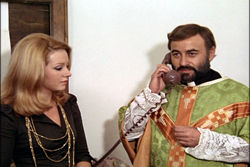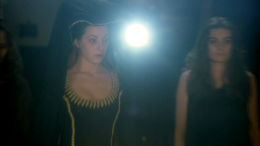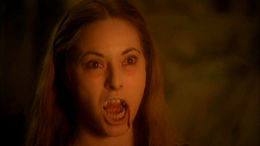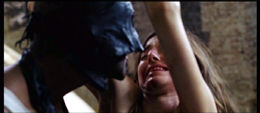
Color, 1975, 89m.
Directed by Juan Bosch / Starring Paul Naschy, Grace Mills, Maria Perschy, Maria Kosti
BCI/Eclipse (US R0 NTSC)

Color, 1975, 89m.
Directed by Juan Bosch / Starring Paul Naschy, Grace Mills, Maria Perschy, Maria Kosti
BCI/Eclipse (US R0 NTSC)
 deep Catholic cultural influences inspired filmmakers to offer their own stories of manly priests facing down plucky possessed adolescents. Though not as well known as its more extravagant Italian cousins, Exorcism presents a uniquely Spanish take courtesy of horror legend Paul Naschy in a rare heroic role. The film begins with pretty Leila (Mills) joining her hippie boyfriend for a satanic ritual out in the middle of nowhere, with plenty of blood spilling into goblets. No sooner than you can mutter "Dracula A.D. 1972," she smashes her car on the way home and soon becomes possessed by a diabolical force -- well, the spirit of her brutish dead father, anyway. Her mom Patricia (Perschy) is none too pleased when Leila (who's also the object of lust for every male employee affiliated with the household) starts disrupting birthday parties and flailing around on the floor, and nasty murders begin to pop up nearby. Can burly Father Adrian (Naschy) purge the demon from her body before it's too late?
deep Catholic cultural influences inspired filmmakers to offer their own stories of manly priests facing down plucky possessed adolescents. Though not as well known as its more extravagant Italian cousins, Exorcism presents a uniquely Spanish take courtesy of horror legend Paul Naschy in a rare heroic role. The film begins with pretty Leila (Mills) joining her hippie boyfriend for a satanic ritual out in the middle of nowhere, with plenty of blood spilling into goblets. No sooner than you can mutter "Dracula A.D. 1972," she smashes her car on the way home and soon becomes possessed by a diabolical force -- well, the spirit of her brutish dead father, anyway. Her mom Patricia (Perschy) is none too pleased when Leila (who's also the object of lust for every male employee affiliated with the household) starts disrupting birthday parties and flailing around on the floor, and nasty murders begin to pop up nearby. Can burly Father Adrian (Naschy) purge the demon from her body before it's too late?
 As with most Spanish horror films of its era, Exorcism was prepared in versions tailored for both its puritanical domestic release and saucier markets abroad. Even so, the nudity and bloodshed are mostly confined to the opening and closing sequences, with lots of angst-ridden scenes in between as Leila's family squabbles and tears itself apart under the watchful eye of the tobacco-lovin' priest. Luckily the horror passages are lively enough to ensure a modest cult following, with a particularly amusing German Shepherd bit at the end that predates Suspiria. Director Juan Bosch doesn't do much to lend any style or atmosphere (or even give it a coherent ending), but Naschy's committed participation (which extended to writing the screenplay, which he insists predates William Friedkin's film) and the fun Hammond organ-laced score by enigmatic composer Alberto Argudo will bring a smile to the face of any Eurocult devotee. And like most Exorcist cash-ins, this one made a mint around the world and proved to be one of Naschy's most commerical outings.
As with most Spanish horror films of its era, Exorcism was prepared in versions tailored for both its puritanical domestic release and saucier markets abroad. Even so, the nudity and bloodshed are mostly confined to the opening and closing sequences, with lots of angst-ridden scenes in between as Leila's family squabbles and tears itself apart under the watchful eye of the tobacco-lovin' priest. Luckily the horror passages are lively enough to ensure a modest cult following, with a particularly amusing German Shepherd bit at the end that predates Suspiria. Director Juan Bosch doesn't do much to lend any style or atmosphere (or even give it a coherent ending), but Naschy's committed participation (which extended to writing the screenplay, which he insists predates William Friedkin's film) and the fun Hammond organ-laced score by enigmatic composer Alberto Argudo will bring a smile to the face of any Eurocult devotee. And like most Exorcist cash-ins, this one made a mint around the world and proved to be one of Naschy's most commerical outings.
 courtesy of BCI Eclipse's lovingly-assembled special edition. Though the film has a rather dark and muted mid-'70s look, the picture quality is miles ahead of any other incarnation, video or theatrical. For some inexplicable reason the film is presented completely open matte, though compositions look much better matted off to around 1.78:1 on widescreen TVs (with the credits obviously framed to be seen in this aspect ratio as well). So if you can zoom in to cut off that empty space at the top and bottom of the screen, do it; the film plays much better that way. Either way the picture quality is fantastic, though. The audio can be played either in the original Spanish (thank God) with optional English subtitles, or the amusingly hamfisted English dub track.
courtesy of BCI Eclipse's lovingly-assembled special edition. Though the film has a rather dark and muted mid-'70s look, the picture quality is miles ahead of any other incarnation, video or theatrical. For some inexplicable reason the film is presented completely open matte, though compositions look much better matted off to around 1.78:1 on widescreen TVs (with the credits obviously framed to be seen in this aspect ratio as well). So if you can zoom in to cut off that empty space at the top and bottom of the screen, do it; the film plays much better that way. Either way the picture quality is fantastic, though. The audio can be played either in the original Spanish (thank God) with optional English subtitles, or the amusingly hamfisted English dub track.

Color, 1972, 87m.
Directed by Paul Naschy (Jacinto Molina)
Starring Paul Naschy, Julia Saly, Silvia Aguilar, Azucena Hernandez
BCI/Eclipse (US R0 NTSC) / WS (1.85:1) (16:9) / DD5.1
 it confused countless renters unfamiliar with the history of Naschy's unfortunate shapeshifting hero, Waldemar Daninsky. However, his fans quickly saw through the lousy transfers and haphazard dubbing to recognize one of his finest and most fully-formed efforts, an atmospheric and wonderfully gothic (and thoughtful!) monsterthon that ranks among his finest.
it confused countless renters unfamiliar with the history of Naschy's unfortunate shapeshifting hero, Waldemar Daninsky. However, his fans quickly saw through the lousy transfers and haphazard dubbing to recognize one of his finest and most fully-formed efforts, an atmospheric and wonderfully gothic (and thoughtful!) monsterthon that ranks among his finest.
 torment, while decadent Erika plans to revive Bathory and become her disciple. Before long, the villagers are being attacked by a familiar furry beast, Bathory is slurping down the blood of, uh, non-virgins, and a beastly showdown is quickly brewing.
torment, while decadent Erika plans to revive Bathory and become her disciple. Before long, the villagers are being attacked by a familiar furry beast, Bathory is slurping down the blood of, uh, non-virgins, and a beastly showdown is quickly brewing.
 A gargantuan improvement over all past video versions, BCI's DVD of The Night of the Werewolf looks radiant throughout with pin-sharp detail and eye-popping color definition. It's easily one of the most beautiful presentations of a Naschy film on home video to date and most likely better than what few theatrical prints might be left lying around. Naschy contributes a new, shot-on-video introduction to the film in which he welcomes the viewer and gives a quick bit of context for this release, which is presented in both the (awful) English dub, original Spanish mono with optional English subtitles (the best option), or a rechanneled 5.1 Spanish audio mix which overzealously pumps too much information (including dialogue) into the front and rear channels. The wonderfully ornate menu design also leads you to the rest of the extras including the optional Spanish titles, a long and strangely lethargic European trailer (playable in either Spanish or English), some brief disposable deleted footage from the robber scene, and two mammoth galleries of stills and artwork compiled with the aid of Naschy scholar Mirek Lipinski, who also contributes the stellar liner notes housed within the DVD case. For hi-def fans, this is also available in an even more eye-popping Blu-Ray double feature with Vengeance of the Zombies (see below), affording you the most crystal-clear Naschy experience possible. Easily one of the top-tier Eurocult releases of the year and recommended without hesitation.
A gargantuan improvement over all past video versions, BCI's DVD of The Night of the Werewolf looks radiant throughout with pin-sharp detail and eye-popping color definition. It's easily one of the most beautiful presentations of a Naschy film on home video to date and most likely better than what few theatrical prints might be left lying around. Naschy contributes a new, shot-on-video introduction to the film in which he welcomes the viewer and gives a quick bit of context for this release, which is presented in both the (awful) English dub, original Spanish mono with optional English subtitles (the best option), or a rechanneled 5.1 Spanish audio mix which overzealously pumps too much information (including dialogue) into the front and rear channels. The wonderfully ornate menu design also leads you to the rest of the extras including the optional Spanish titles, a long and strangely lethargic European trailer (playable in either Spanish or English), some brief disposable deleted footage from the robber scene, and two mammoth galleries of stills and artwork compiled with the aid of Naschy scholar Mirek Lipinski, who also contributes the stellar liner notes housed within the DVD case. For hi-def fans, this is also available in an even more eye-popping Blu-Ray double feature with Vengeance of the Zombies (see below), affording you the most crystal-clear Naschy experience possible. Easily one of the top-tier Eurocult releases of the year and recommended without hesitation.

Color, 1972, 87m.
Directed by Leon Klimovsky
Starring Paul Naschy, Romy, Mirta Miller, Vic Winner, Maria Kosty, Aurora de Alba, Pierre Besari
BCI/Eclipse (US R0 NTSC)
 one of the weirdest Paul-on-parade spectacles must certainly be Vengeance of the Zombies, which features the stocky leading man going through a variety of make-up permutations under the guidance of regular director Leon Klimovsky.
one of the weirdest Paul-on-parade spectacles must certainly be Vengeance of the Zombies, which features the stocky leading man going through a variety of make-up permutations under the guidance of regular director Leon Klimovsky.
 As with Naschy's other London-set monster outing, Dr. Jekyll vs. the Werewolf, he and Klimovsky strive to emulate the freewheeling early '70s ambience of drug-and-sex-sodden Old Blighty being similarly mined by Hammer films (see Dracula A.D. 1972 for the most ridiculous example). However, the Spanish approach automatically gives the proceedings a flavor far different from its Hammer counterparts, with much looser plotting (you could barely even tell this film has a storyline per se) and plenty of enthusiastic skin and fake blood for the crowds outside of censor-happy Spain. Few of Naschy and Klimovsky's films could really be termed "scary" in the traditional sense, but the imagery here of undead, bug-eyed female corpses in flowing blue gowns is certainly some of the creepiest they ever concocted.
As with Naschy's other London-set monster outing, Dr. Jekyll vs. the Werewolf, he and Klimovsky strive to emulate the freewheeling early '70s ambience of drug-and-sex-sodden Old Blighty being similarly mined by Hammer films (see Dracula A.D. 1972 for the most ridiculous example). However, the Spanish approach automatically gives the proceedings a flavor far different from its Hammer counterparts, with much looser plotting (you could barely even tell this film has a storyline per se) and plenty of enthusiastic skin and fake blood for the crowds outside of censor-happy Spain. Few of Naschy and Klimovsky's films could really be termed "scary" in the traditional sense, but the imagery here of undead, bug-eyed female corpses in flowing blue gowns is certainly some of the creepiest they ever concocted.
 open matte 1.33:1 framing shown here is functional enough, though viewers with widescreen monitors may want to zoom it in to 1.78:1 for a far more interesting and aesthetically pleasing presentation. Colors look excellent, and black levels look dead on (though the original film stock makes some shadowy scenes a bit murkier than what might have been intended).
open matte 1.33:1 framing shown here is functional enough, though viewers with widescreen monitors may want to zoom it in to 1.78:1 for a far more interesting and aesthetically pleasing presentation. Colors look excellent, and black levels look dead on (though the original film stock makes some shadowy scenes a bit murkier than what might have been intended).

Color, 2004, 90m.
Directed by Christian Molina
Starring Paul Naschy, Mehn-Wai, Miguel Del Arco, Bibiana Fernandez, Guillermo Montesinos
Media Blasters (UK R0 PAL) / WS (2.35:1) / DD2.0
 changing social climate. Directed by first-time helmer Christian Molina (no relation to Naschy, whose real name is Jacinto Molina), this semi-comic look at the struggling horror biz features Naschy as Pablo Thevenet, a once adored thespian whose days in the sun have now faded with audiences flocking to the newest flavor of the month. Now he's reduced to begging agents for parts (while not regaling other wannabes with tales of his own hilarious sexual perversions) and taking demeaning jobs at high-end brothels, a situation which ultimately sends him over the brink. Faster than you can say Fade to Black, he's dressing himself up as famous figures of historical terror (Jack the Ripper, etc.) and knocking off anyone
changing social climate. Directed by first-time helmer Christian Molina (no relation to Naschy, whose real name is Jacinto Molina), this semi-comic look at the struggling horror biz features Naschy as Pablo Thevenet, a once adored thespian whose days in the sun have now faded with audiences flocking to the newest flavor of the month. Now he's reduced to begging agents for parts (while not regaling other wannabes with tales of his own hilarious sexual perversions) and taking demeaning jobs at high-end brothels, a situation which ultimately sends him over the brink. Faster than you can say Fade to Black, he's dressing himself up as famous figures of historical terror (Jack the Ripper, etc.) and knocking off anyone  who raises his ire, all under the watchful eye of his new boss, Reficul (any relation to Lou Cyphre and Johnny Alucard?), played by Plenilunio's Del Arco.
who raises his ire, all under the watchful eye of his new boss, Reficul (any relation to Lou Cyphre and Johnny Alucard?), played by Plenilunio's Del Arco.
 One of the inaugural titles in the Fangoria International line through Shriek Show, Rojo Sangre gets the deluxe treatment with one caveat. The letterboxed transfer looks excellent, as expected from a film of this vintage, though inexplicably it's not enhanced for 16x9 televisions; as a result, English viewers with widescreen displays will be stuck watching the film radically windowboxed on all fours sides to watch it with subtitles. The stereo Spanish audio sounds fine, with a few fancy directional effects thrown in especially during the surreal final half hour.
One of the inaugural titles in the Fangoria International line through Shriek Show, Rojo Sangre gets the deluxe treatment with one caveat. The letterboxed transfer looks excellent, as expected from a film of this vintage, though inexplicably it's not enhanced for 16x9 televisions; as a result, English viewers with widescreen displays will be stuck watching the film radically windowboxed on all fours sides to watch it with subtitles. The stereo Spanish audio sounds fine, with a few fancy directional effects thrown in especially during the surreal final half hour.